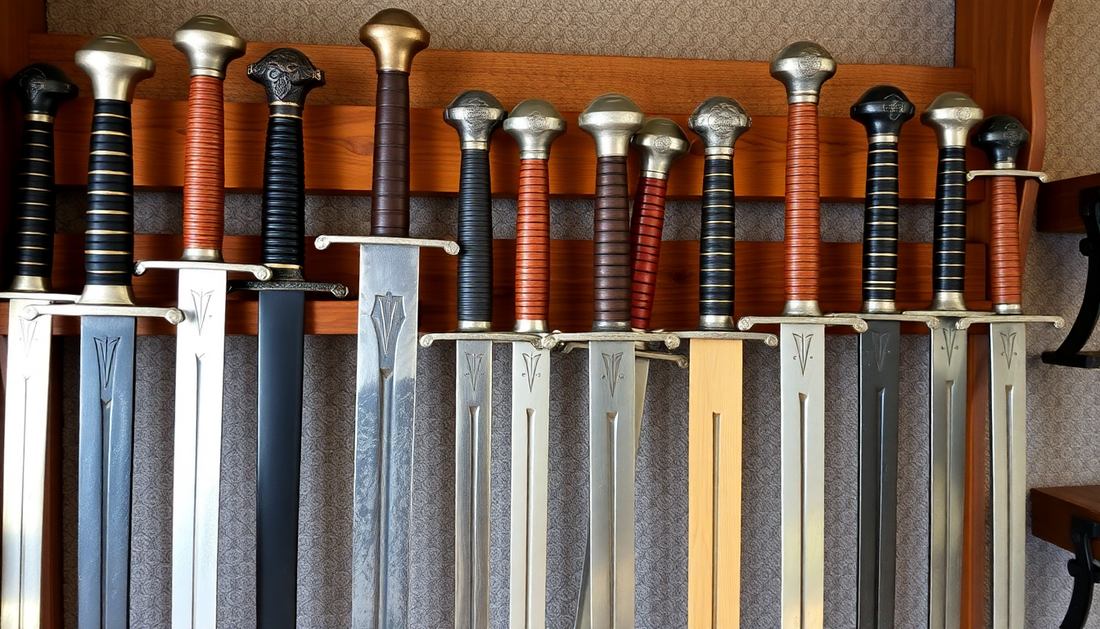
Sword Styles Explained: Which One is Right for You?
Share
Sword Styles Explained: Which One is Right for You?
Medieval swords hold a special place in history. They symbolize power, craftsmanship, and the art of warfare. Understanding different medieval sword designs can enhance your appreciation and help you choose the perfect sword for your needs. Whether you are a collector, reenactor, or history enthusiast, this guide will help you navigate the world of medieval swords.
Types of Medieval Swords
One-Handed Swords
One-handed swords are among the most popular types of medieval swords. Lightweight and versatile, these swords can be used effectively in close combat. The design allows for quick movements, making them ideal for both offensive and defensive strategies.
Examples of one-handed swords include the famous broadsword and arming sword. The arming sword is a classic choice, often used by knights. It balances speed with effectiveness, making it suitable for various combat scenarios.
Two-Handed Swords
Two-handed swords, as the name suggests, require both hands to wield. These swords are typically heavier and longer than their one-handed counterparts. The added length and weight give them more cutting power, making them ideal for breaking through enemy lines.
Some famous examples include the longsword and the greatsword. The longsword is known for its versatility and effectiveness in both cutting and thrusting. Historical battles often featured these mighty weapons wielded by knights.
Specialty Swords
Not all swords fit neatly into the one-handed or two-handed categories. Specialty swords, such as sabers and rapiers, offer unique characteristics catering to specific fighting styles or purposes.
Sabers are curved swords that excel in slashing movements, often used by cavalry. Rapiers, on the other hand, are designed for thrusting, making them well-suited for dueling. Their slender design and intricate craftsmanship make them favorites among collectors.
Hand-Forged Medieval Swords
What Are Hand-Forged Swords?
Hand-forged medieval swords are made through a meticulous process of heating and shaping metal. Artisans hammer the steel to create a durable, high-quality blade. This process differentiates hand-forged swords from mass-produced options that may lack the same level of craftsmanship.
Choosing hand-forged medieval swords means investing in a piece of art with authenticity. The blade's performance and durability make hand-forging a desirable trait for users and collectors alike.
The Art of Forging
The craftsmanship involved in creating hand-forged swords is an art form. Blacksmiths utilize quality materials and time-tested techniques to ensure that each sword meets high standards.
From choosing the right steel to perfecting the heat treatment, each step is crucial in producing exceptional hand-forged swords. The result is a weapon that offers both beauty and functionality, perfect for reenactors and collectors.
Decorative vs Functional Swords
Understanding Decorative Swords
Decorative swords are designed primarily for display rather than combat. They often feature intricate designs, ornate hilts, and detailed engravings. Though visually stunning, they may lack the durability or balance suited for practical use.
Collections may feature these wonderful pieces, but they are typically used for display purposes, making them ideal for enthusiasts who appreciate the artistry behind sword-making.
Benefits of Functional Swords
Conversely, functional swords are crafted for actual use in combat or reenactments. These swords are designed to be sharp, balanced, and durable, suitable for various scenarios.
If you're planning to use your sword for demonstrations or historical re-enactments, a functional sword is your best choice. It ensures safety while maintaining historical accuracy.
Medieval Sword Styles Comparison
Features of Different Styles
When comparing medieval sword styles, several key characteristics come into play. One-handed swords are agile and quick, making them great for close-range fighting. Two-handed swords, while more powerful, require more skill to wield effectively.
Specialty swords further add to this diversity. Sabers are fantastic for fast, slashing attacks, while rapiers are designed for precise thrusts. Understanding these differences can help you make an informed choice on the right style for your needs.
Choosing the Right Style for You
Selecting the best sword style involves considering your intended use. Do you need a sword for display, practice, or combat? Think about your preferences and how you plan to use the sword.
If you're a history reenactor, a functional two-handed sword could be your best bet. For collectors, a beautifully crafted decorative blade may be more fitting. Assess your needs carefully to ensure you find a sword that matches your requirements.
How to Choose a Medieval Sword
Assessing Your Needs
The first step in choosing a medieval sword is to determine its primary purpose. Will you use it for practice, display, or historical reenactments? Understanding your needs will guide you in making a decision.
If you're a collector who appreciates ornate craftsmanship, you may lean toward decorative swords. In contrast, those training in combat may want a hand-forged functional sword.
Factors Influencing Your Choice
Several factors impact your choice as you narrow down options. Weight, balance, and ergonomics are vital considerations. You want a sword that feels comfortable to wield while providing control.
Additionally, consider materials and aesthetic preferences. A high-quality blade made from superior steel will ensure durability and performance in hand-forged medieval swords.
Conclusion
In summary, understanding the different medieval sword designs can significantly impact your selection process. Knowing the types, craftsmanship involved, and your specific needs helps ensure you make the right choice. At Knight's Collection, we offer a variety of swords, from stunning hand-forged blades to decorative masterpieces. Explore our collection today to find the perfect medieval sword that speaks to your history and passion!
